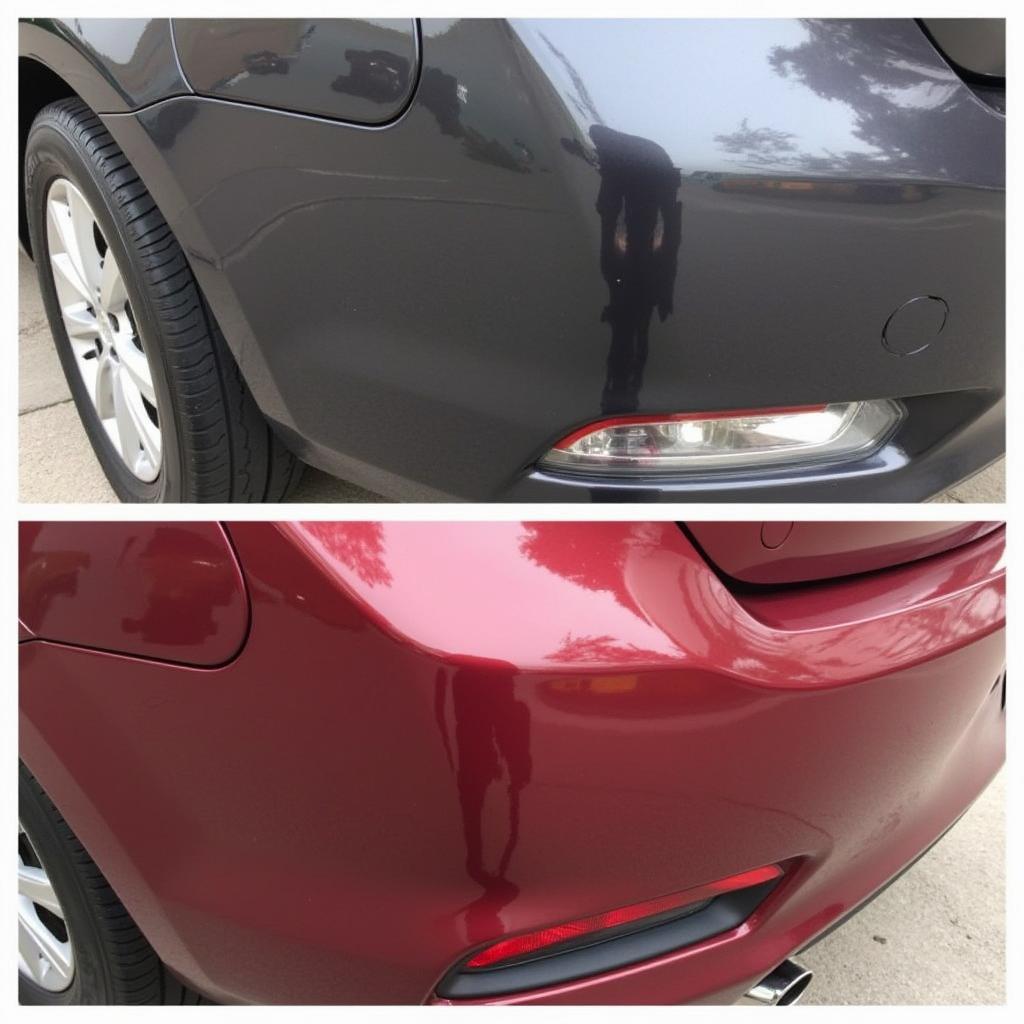Discovering a deep scratch on your car bumper or door can be disheartening. Whether it’s from a minor accident, a rogue shopping cart, or an act of nature, these blemishes can detract from your car’s appearance and potentially impact its resale value. While fixing deep scratches might seem like a job best left to professionals, with the right tools and guidance, you can tackle this repair yourself and restore your car’s exterior to its former glory.
Before rushing to the nearest auto body shop, consider tackling the repair yourself. Understanding the depth and extent of the damage is crucial in determining the best course of action.
Assessing the Damage: Is it a DIY Fix?
Not all scratches are created equal. A light scratch that only affects the clear coat can often be remedied with a bit of polishing compound. However, deep scratches that cut through the paint layers and expose the bare metal require a more involved approach.
Here’s how to determine the severity:
- Surface Scratch: If you can’t feel the scratch with your fingernail and it appears more like a scuff mark, it’s likely a surface scratch.
- Deep Scratch: If your fingernail catches on the scratch or you can see the metal beneath the paint, it’s classified as a deep scratch.
Gathering Your Scratch Repair Arsenal
Before you begin the repair process, gather the necessary tools and materials. Having everything on hand will make the task more efficient and ensure a smoother repair.
Here’s what you’ll need:
- Cleaning Supplies: Car wash soap, water, microfiber cloths
- Sandpaper: 200-grit, 400-grit, 600-grit (for deeper scratches)
- Masking Tape: To protect surrounding areas
- Primer (if metal is exposed)
- Touch-up Paint: Matching your car’s paint code
- Clear Coat: For a protective and glossy finish
- Rubbing Compound
- Polishing Compound
- Applicators: Foam or microfiber
The Step-by-Step Guide to Repairing Deep Scratches
Successfully repairing a deep scratch requires patience and attention to detail. Follow these steps to achieve professional-looking results:
1. Clean the Area:
Thoroughly wash the damaged area with car wash soap and water. Allow it to dry completely.
2. Mask the Area:
Apply masking tape around the scratch, leaving a small border to protect the surrounding paint.
3. Sand the Scratch:
- Deep Scratches: Start with 200-grit sandpaper, sanding in a back-and-forth motion along the length of the scratch. Gradually increase the grit (400, then 600) to smooth out the surface.
- Light Scratches: If you’re dealing with a less severe scratch, you can likely skip to 400-grit sandpaper.
4. Prime Exposed Metal (If Needed):
If sanding has exposed the bare metal, apply a thin coat of automotive primer to prevent rust. Allow it to dry completely.
5. Apply Touch-up Paint:
- Using a Brush: If the scratch is small, carefully apply thin coats of touch-up paint, allowing each coat to dry before applying the next.
- Using a Spray Can: For larger scratches, hold the can 6-8 inches away and apply thin, even coats.
6. Apply Clear Coat:
Once the paint is dry, apply 2-3 thin coats of clear coat, allowing for drying time between each coat.
7. Wet Sand and Buff:
- After the clear coat has cured (usually 24-48 hours), use 1000-grit or finer sandpaper soaked in water to lightly sand the area.
- Use rubbing compound and a polishing compound with a microfiber cloth to buff the area to a high gloss.
 Car Bumper After Scratch Repair
Car Bumper After Scratch Repair
Expert Insights on Deep Scratch Repair
“Many car owners underestimate their ability to tackle minor bodywork repairs,” says automotive expert, John Davis. “With a little patience and the right materials, repairing deep scratches on your car bumper or door is entirely achievable.” Davis emphasizes the importance of proper surface preparation and using high-quality automotive paint that matches your car’s exact color code.
Conclusion
Repairing deep scratches on your car bumper or door might seem daunting, but by following this comprehensive guide, you can achieve professional-looking results from the comfort of your own garage. Remember to take your time, follow the steps meticulously, and use high-quality products to ensure a lasting and seamless repair. With a bit of effort, you can restore your car’s exterior and regain its pristine appearance.
FAQ:
Q: Can I use nail polish to fix a car scratch?
A: While tempting, it’s not recommended. Nail polish lacks the durability and UV protection of automotive paint and won’t offer a lasting repair.
Q: Where can I find my car’s paint code?
A: Your car’s paint code is usually located on a sticker inside the driver’s side door jamb, glove box, or under the hood.
Q: How long does it take for touch-up paint to dry?
A: Drying times vary depending on the type of paint and environmental conditions. It’s best to refer to the paint manufacturer’s instructions for specific drying times.
Q: Can I wash my car after repairing a scratch?
A: It’s advisable to wait at least 48 hours after the final clear coat application before washing your car.
Q: What if the scratch is too deep to repair myself?
A: For very deep or extensive damage, it’s best to consult with a professional auto body repair shop.
Need help with car diagnosis or repair? Contact us via WhatsApp: +1(641)206-8880, Email: [email protected]. Our dedicated customer support team is available 24/7 to assist you.
